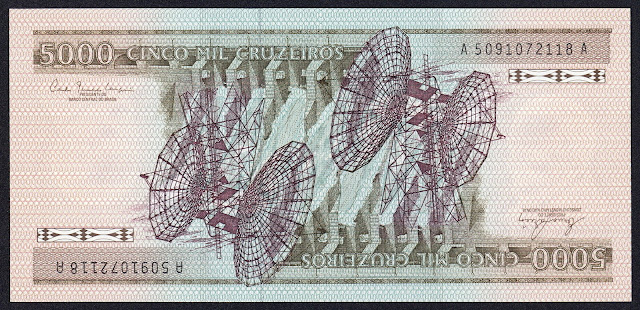Brazil Banknotes 5000 Cruzeiros banknote 1982 Castelo Branco
Central Bank of Brazil - Banco Central do Brasil
Obverse: Double portrait of Marshal Humberto de Alencar Castelo Branco (26th President of Brazil in 1964-1967) at center. BANCO CENTRAL DO BRASIL in two lines.
Reverse: Double view of hydroelectric dam and radio antennae representing hydroelectric energy and telecommunications of Brazil.
Watermark: portrait of Humberto de Alencar Castelo Branco.
Face Color: Purple and brown on multicolor underprint.
Back Color: Brown, purple and blue.
Printer: Casa da Moeda do Brasil (CdM-B).
Dimensions: 154 x 74 mm.
Signatures: Presidente Conselho Monetário: Ernane Galvas.
Presidente do Banco Central do Brasil: Carlos Geraldo Langoni.
Brazilian Currency Banknotes - Brazil Paper Money
1981-1985 Issue
5000 Cruzeiros 10000 Cruzeiros 50000 Cruzeiros 100000 Cruzeiros
Marshal Humberto de Alencar Castelo Branco
Marshal Humberto de Alencar Castelo Branco (20 September 1897 – 18 July 1967) was a Brazilian military leader and politician.
He served as President of Brazil after the 1964 military coup d'etat. He was killed in an aircraft collision in July 1967, soon after resigning his office.
Castelo Branco was descended from a wealthy Northeastern Brazilian family. His father, Cândido Borges Castelo Branco, had also been a general. His mother, Antonieta Alencar Castelo Branco, came from an intellectual family (which included the writer José de Alencar).
Castelo Branco married Argentina Vianna, and had two children, Nieta and Paulo.
Military career
Castelo Branco joined the Brazilian Army in 1918. He was a student at a military school, the Escola Militar de Realengo (in Rio de Janeiro), then in 1921 he joined the 12th Infantry Regiment in Belo Horizonte. In 1927, he returned to his military school as an infantry instructor. He was promoted to captain in 1938.
As a captain, he studied in England. He was made a lieutenant colonel in 1943. During World War II, he was a colonel in the Brazilian Expeditionary Force which fought in Italy against Germany. He served as "Chief of the Operations Section" ("chefe de seção de operações") and is said to have spent 300 days in combat zones.
Castelo Branco subsequently wrote a large number of academic studies and treatises on the conduct of war. He was appointed Chief of Staff of the Army by President João Goulart in 1963 and a marshal (of reserves) in 1964.
Political career
Castelo Branco became one of the leaders of the coup d'etat of March 31, 1964 that overthrew Goulart. On April 11, Congress chose him to serve out the balance of Goulart's term. He took the oath of office on April 15, 1964
Castelo Branco was the second Brazilian Field Marshal to become president of the nation through a coup d'état—the first was Deodoro da Fonseca, who deposed the monarchic government of Emperor Dom Pedro II of Brazil in 1889.
Castelo Branco’s government, differently from previous directly elected presidents Juscelino Kubitschek, Jânio Quadros and João Goulart, was bankrolled from the start by the credits and loans from World Bank, International Monetary Fund and massive investment from multinational American companies, which saw the Brazilian right-wing military dictatorship as a new, economically stable Western ally against international communism — mainly in Latin America — during the Cold War.
Castelo Branco was vested with emergency powers under the First Institutional Act, which among other things allowed him to cancel the political rights of "subversive elements" for ten years. However, he was otherwise committed to permitting normal political activities while carrying out reform through legislation. He also had every intention of turning over power to a popularly elected president when Goulart's term was due to run out in 1966. However, several extreme right-wing civilian and military elements felt the military needed to stay in power for a number of years in order to root out subversion. Events reached a breaking point in October 1965, when opposition candidates won the governorships of the major states of Minas Gerais and Guanabara. The extremists demanded that Castelo Branco annul the results, but he refused. A coup was only averted when War Minister Artur Da Costa e Silva persuaded the extremists to let the results stand in return for Castelo Branco's promise to take a tougher line.
Thereafter, Castelo Branco dropped all pretense of democracy. On October 27, he issued the Second Institutional Act, which abolished all existing political parties, restored his emergency powers, and extended his term to 1967. The numerous parties were replaced with only two: the pro-government National Renewal Alliance Party (ARENA) and the opposition Brazilian Democratic Movement (MDB). In 1967, he convened an extraordinary commission of jurists that crafted a highly authoritarian constitution.
He issued many repressive laws, most notably a highly draconian press law (Lei de Imprensa) near the end of his term. This law continued to be valid in Brazil until 2009, when it was struck down by Brazil’s Supreme Federal Court. He was succeeded by Costa e Silva.
He promoted government intervention into the economy (e.g., shutting down by decree the country's flag carrier, Panair do Brasil) and tributary reforms.
Six months after leaving the presidency, Castelo Branco died in a midair collision of small aircraft near Fortaleza.

